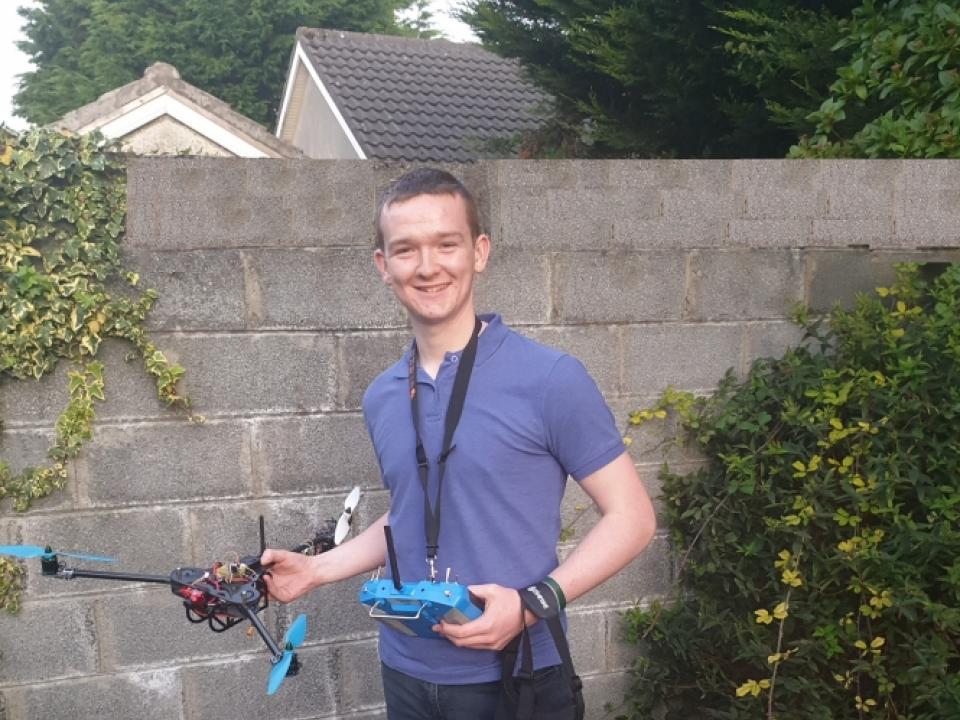Student's livestock monitoring drone shortlisted for Ploughing Championships Innovation Award
Drone monitors livestock using First Person View camera and Active RDIF technologies
A GMIT engineering student’s final year project, a prototype drone with integrated active RFID reader for monitoring livestock, has been shortlisted for the Innovation Arena Awards competition at this year’s National Ploughing Championship, which takes place in Ballinatrane, Fenagh, Co Carlow from Tuesday 17 to Thursday 19 September.
James Serridge from Castlerea, Co Roscommon, who grew up on a farm and who has just completed his honours degree in Mechanical Engineering at GMIT, says “I always had an interest in machinery, electronics and engineering from a young age which led me to pursue Mechanical Engineering as a career. My final year project is based on making life safer and easier for farmers”.
James’ supervisor, Dr Oliver Mulryan, GMIT Dept of Mechanical and Industrial Engineering, says “Anyone who has grown up on a farm knows the risks. Around 25 farmers die annually in farm accidents, 30% of these fatalities arise due to livestock accidents. Additionally, it can be time-consuming for some farmers to cover their holdings. The average farm size in Ireland is approximately 80 acres.”
James Serridge says: “To help reduce the number of such incidents, I envisioned, designed and manufactured a prototype drone which is capable of monitoring livestock at a safe distance using First Person View camera and Active RDIF technologies.”
“Currently my drone can be piloted through the use of the First-Person View (FPV) technology, in which the live video feed from a camera mounted on the drone can be transmitted to goggles or alternatively to a tv/monitor. However, with the embedded GPS and off the shelf Active RFID technology the drone, with further work, could be programmed for a mission to follow a specific serpentine flightpath around a farmer’s holding”.
“When the active RFID technology is integrated and the drone is flown over an area, the reader mounted on the drone should interrogate and capture the transmitted livestock’s tag data within the proximity of the reader. This distance is typically 30 to 40 meters for active RFID technology. The drone’s onboard GPS could be then used to tag the animals’ location to the transmitted tag data. After the drone’s mission is completed, the acquired data (ie location, time and health information) could be relayed back to the farmer’s smartphone via either Wi-Fi or cellular technology. Although drone use is ubiquitous, to my knowledge there are no drones currently on the market with integrated Active RFID technologies.”
“I would like to take this opportunity to formally thank staff in the GMIT Department of Mechanical and Industrial Engineering for their mentoring and support, also the industry experts at the annual GMIT Departmental Poster Exhibition for their guidance and advice, and Enterprise Ireland and the National Ploughing Association for shortlisting my project.”
For further information about mechanical and industrial engineering courses in GMIT, see: https://www.gmit.ie/mechanical-industrial-engineering/department-mechanical-and-industrial-engineering
Issued by Regina Daly, GMIT Communications Officer.
Tel. 00 353 (0)91 742826/087-9618355 (m) , email: regina.daly@gmit.ie www.gmit.ie/news
